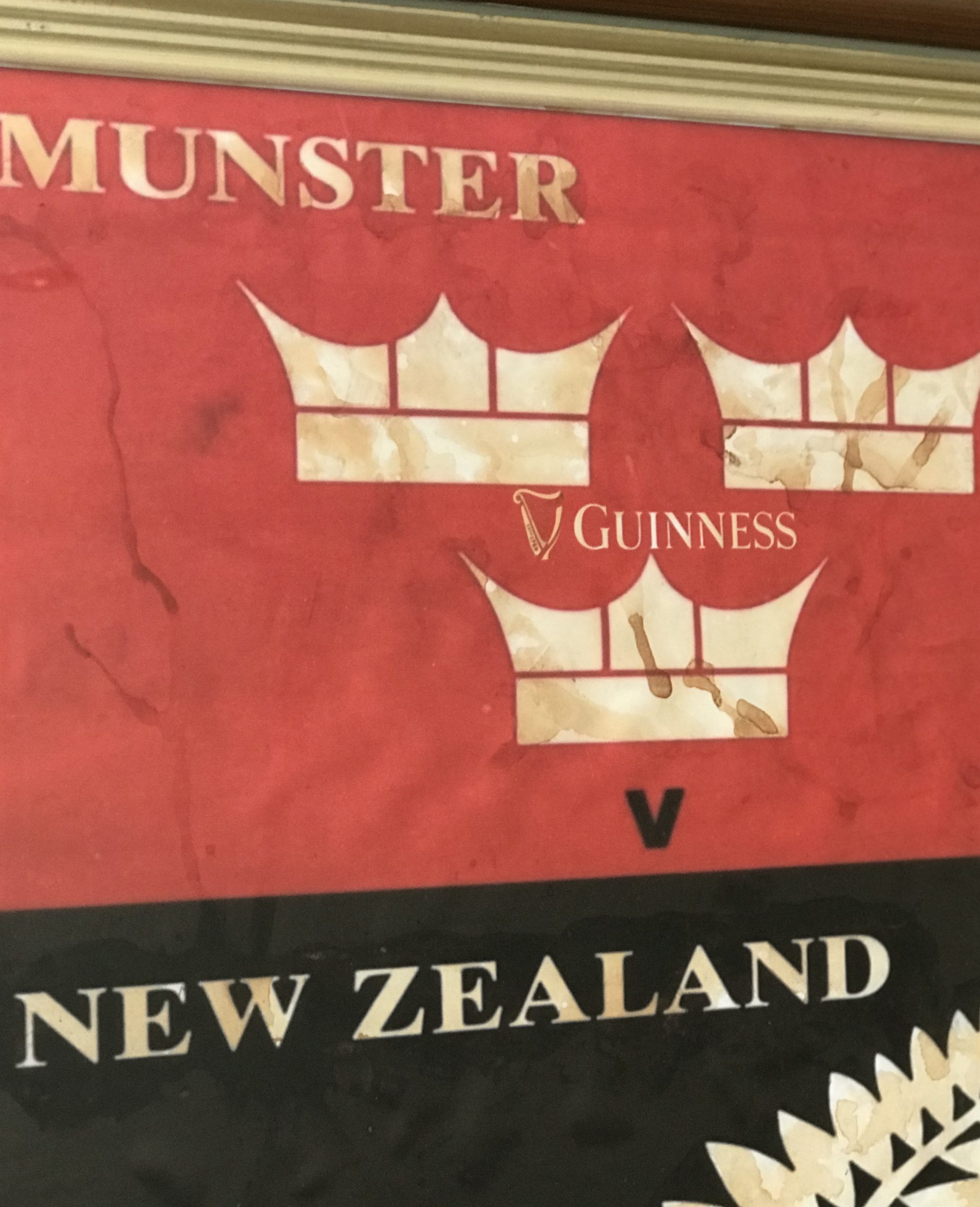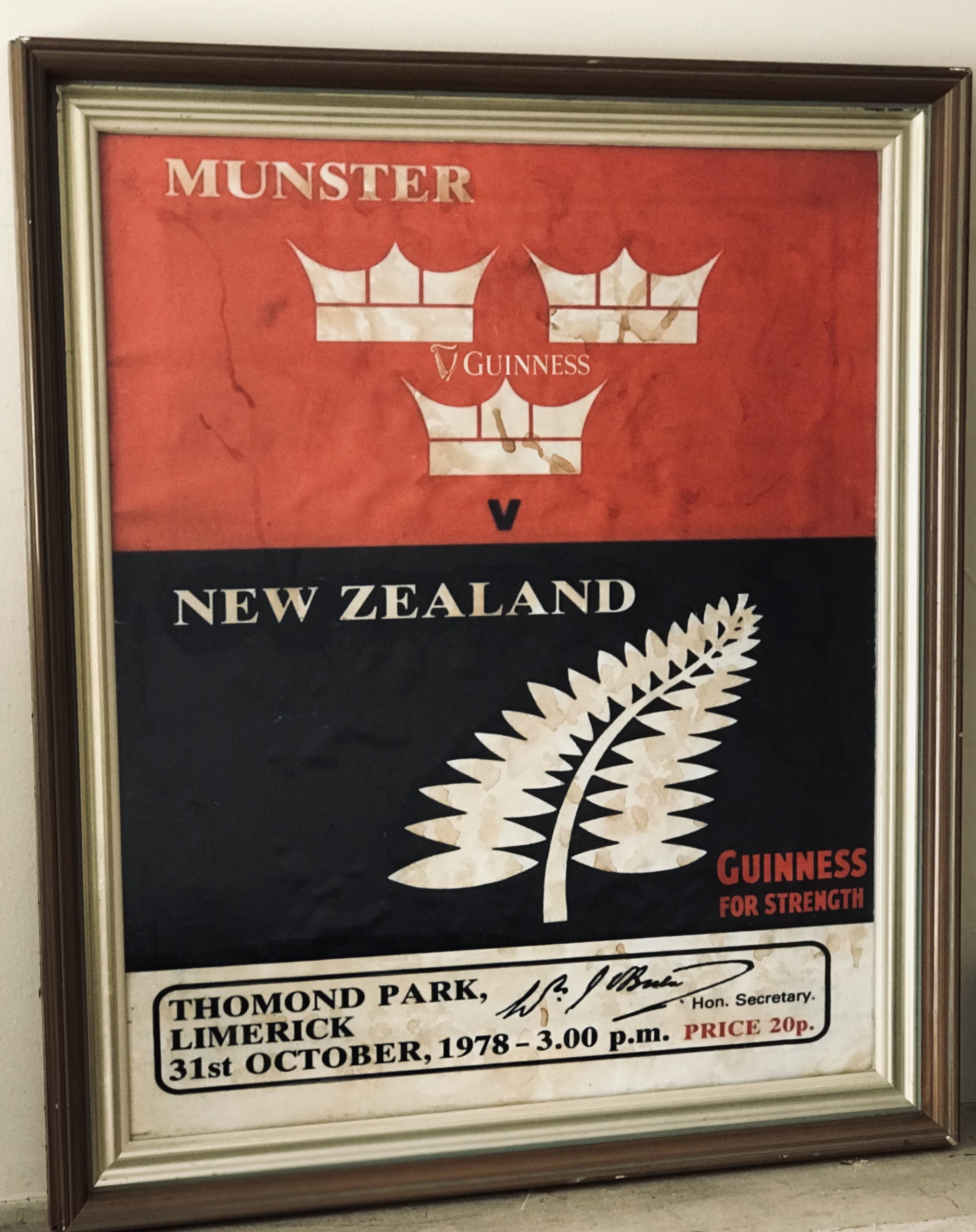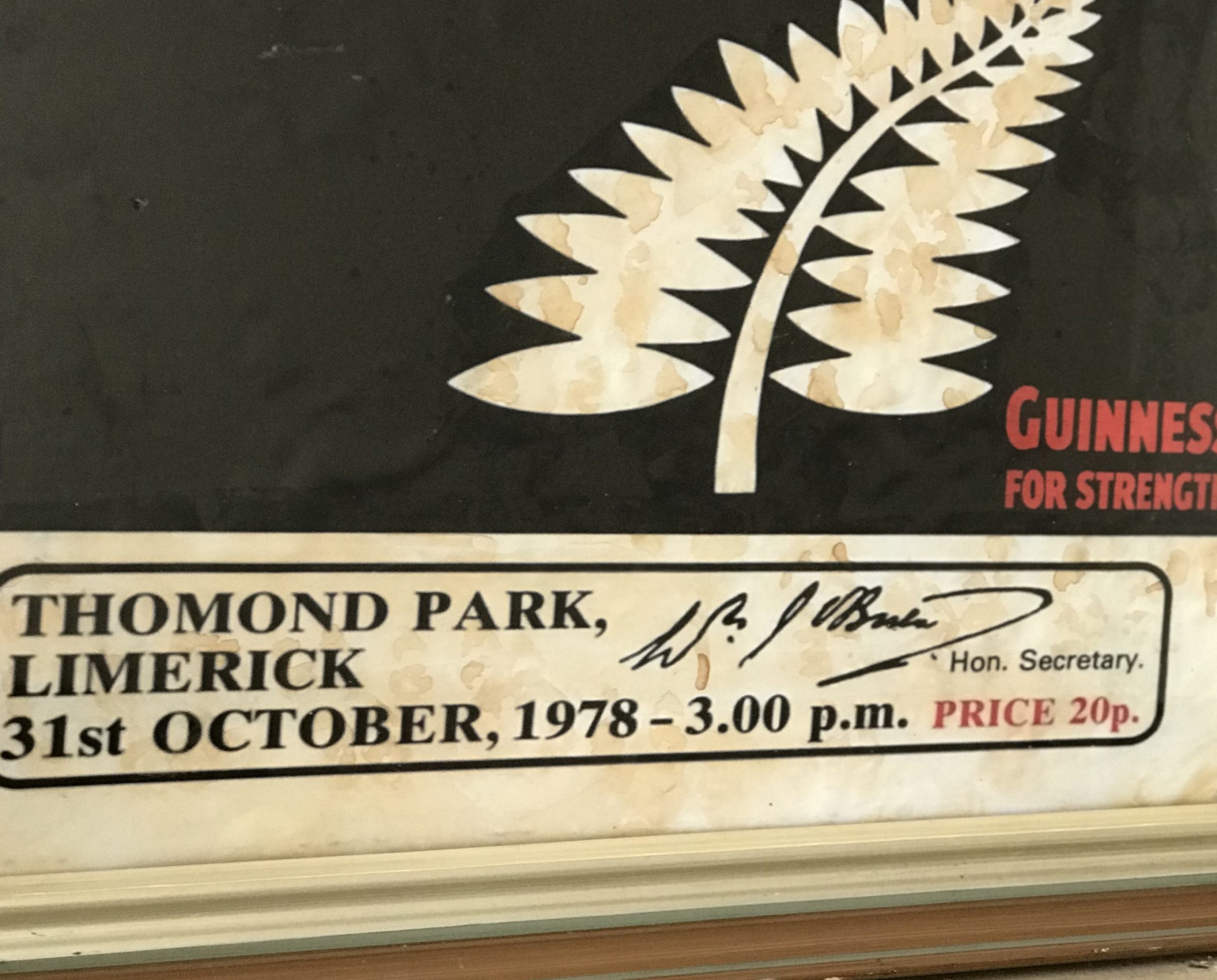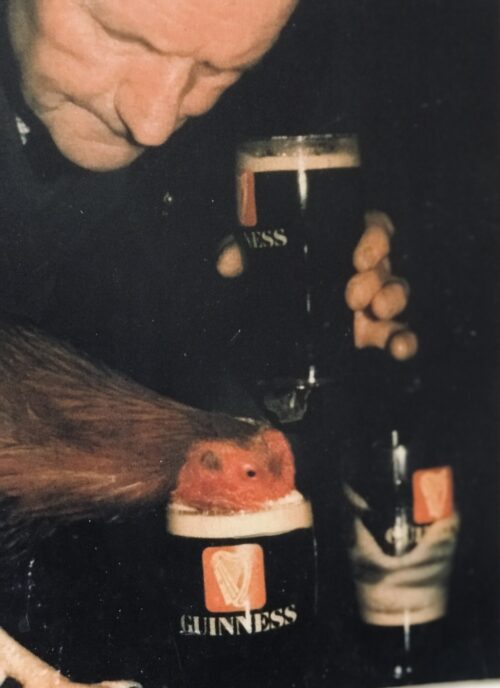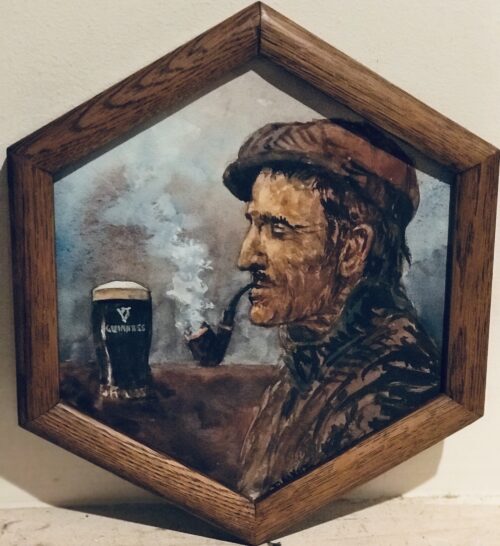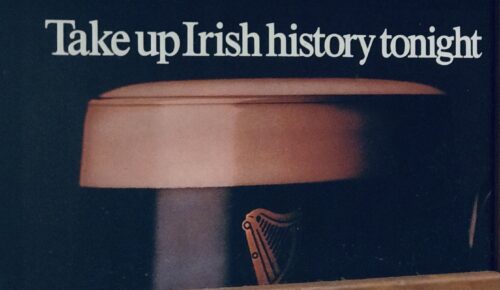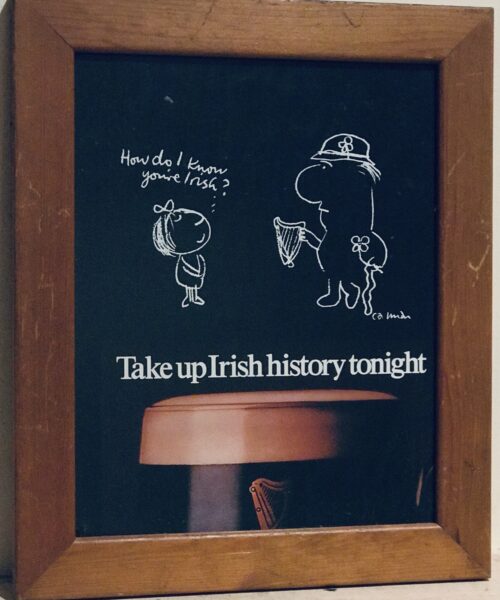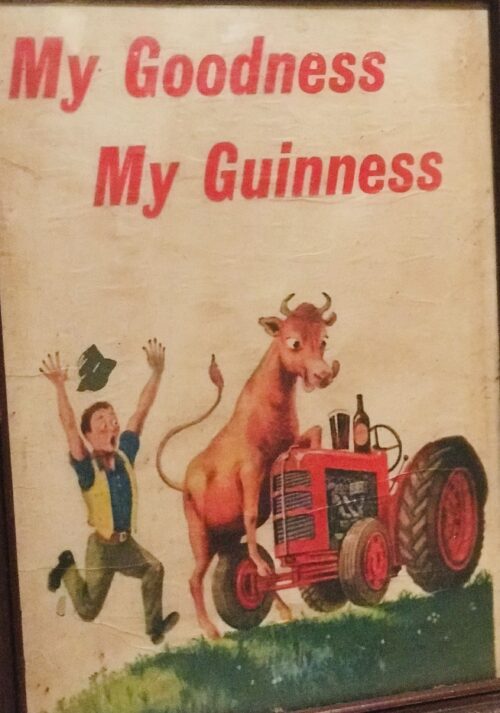There are many chapters in Munster’s storied rugby journey but pride of place remains the game against the otherwise unbeaten New Zealanders on October 31, 1978.This is a beautifully presented, upsized reprographic of the front page of the match programme on that famous day./
70cm x 60cm Limerick City
There were some mighty matches between the Kiwis and Munster, most notably at the Mardyke in 1954 when the tourists edged home by 6-3 and again by the same margin at Thomond Park in 1963 while the teams also played a 3-3 draw at Musgrave Park in 1973. During that time, they resisted the best that Ireland, Ulster and Leinster (admittedly with fewer opportunities) could throw at them so this country was still waiting for any team to put one over on the All Blacks when Graham Mourie’s men arrived in Limerick on October 31st, 1978.
There is always hope but in truth Munster supporters had little else to encourage them as the fateful day dawned. Whereas the New Zealanders had disposed of Cambridge University, Cardiff, West Wales and London Counties with comparative ease, Munster’s preparations had been confined to a couple of games in London where their level of performance, to put it mildly, was a long way short of what would be required to enjoy even a degree of respectability against the All Blacks. They were hammered by Middlesex County and scraped a draw with London Irish.
Ever before those two games, things hadn’t been going according to plan. Tom Kiernan had coached Munster for three seasons in the mid-70s before being appointed Branch President, a role he duly completed at the end of the 1977/78 season.

However, when coach Des Barry resigned for personal reasons, Munster turned once again to Kiernan. Being the great Munster man that he was and remains, Tom was happy to oblige although as an extremely shrewd observer of the game, one also suspected that he spotted something special in this group of players that had escaped most peoples’ attention. He refused to be dismayed by what he saw in the games in London, instead regarding them as crucial in the build-up to the All Blacks encounter. He was, in fact, ahead of his time, as he laid his hands on video footage of the All Blacks games, something unheard of back in those days, nor was he averse to the idea of making changes in key positions. A major case in point was the introduction of London Irish loose-head prop Les White of whom little was known in Munster rugby circles but who convinced the coaching team he was the ideal man to fill a troublesome position.
Kiernan was also being confronted by many other difficult issues. The team he envisaged taking the field against the tourists was composed of six players (Larry Moloney, Seamus Dennison, Gerry McLoughlin, Pat Whelan, Brendan Foley and Colm Tucker) based in Limerick, four (Greg Barrett, Jimmy Bowen, Moss Finn and Christy Cantillon) in Cork, four more (Donal Canniffe, Tony Ward, Moss Keane and Donal Spring) in Dublin and Les White who, according to Keane, “hailed from somewhere in England, at that time nobody knew where”.
Always bearing in mind that the game then was totally amateur and these guys worked for a living, for most people it would have been impossible to bring them all together on a regular basis for six weeks before the match. But the level of respect for Kiernan was so immense that the group would have walked on the proverbial bed of nails for him if he so requested. So they turned up every Wednesday in Fermoy — a kind of halfway house for the guys travelling from three different locations and over appreciable distances.
Those sessions helped to forge a wonderful team spirit. After all, guys who had been slogging away at work only a short few hours previously would hardly make that kind of sacrifice unless they meant business.
October 31, 1978 dawned wet and windy, prompting hope among the faithful that the conditions would suit Munster who could indulge in their traditional approach sometimes described rather vulgarly as “boot, bite and bollock” and, who knows, with the fanatical Thomond Park crowd cheering them on, anything could happen. Ironically, though, the wind and rain had given way to a clear, blue sky and altogether perfect conditions in good time for the kick-off.
Surely, now, that was Munster’s last hope gone — but that didn’t deter more than 12,000 fans from making their way to Thomond Park and somehow finding a spot to view the action. The vantage points included hundreds seated on the 20-foot high boundary wall, others perched on the towering trees immediately outside the ground and some even watched from the windows of houses at the Ballynanty end that have since been demolished.
The atmosphere was absolutely electric as the teams took the field, the All Blacks performed the Haka and the Welsh referee Corris Thomas got things under way.
The first few skirmishes saw the teams sizing each other up before an incident that was to be recorded in song and story occurred, described here — with just the slightest touch of hyperbole! — by Terry McLean in his book ‘Mourie’s All Blacks’.
“In only the fifth minute, Seamus Dennison, him the fellow that bore the number 13 jersey in the centre, was knocked down in a tackle. He came from the Garryowen club which might explain his subsequent actions — to join that club, so it has been said, one must walk barefooted over broken glass, charge naked through searing fires, run the severest gauntlets and, as a final test of manhood, prepare with unfaltering gaze to make a catch of the highest ball ever kicked while aware that at least eight thundering members of your own team are about to knock you down, trample all over you and into the bargain hiss nasty words at you because you forgot to cry out ‘Mark’.
Moss Keane recalled the incident: “It was the hardest tackle I have ever seen and lifted the whole team. That was the moment we knew we could win the game.” Kiernan also acknowledged the importance of “The Tackle”.

Many years on, Stuart Wilson vividly recalled the Dennison tackles and spoke about them in remarkable detail and with commendable honesty: “The move involved me coming in from the blind side wing and it had been working very well on tour. It was a workable move and it was paying off so we just kept rolling it out. Against Munster, the gap opened up brilliantly as it was supposed to except that there was this little guy called Seamus Dennison sitting there in front of me.
“He just basically smacked the living daylights out of me. I dusted myself off and thought, I don’t want to have to do that again. Ten minutes later, we called the same move again thinking we’d change it slightly but, no, it didn’t work and I got hammered again.”
The game was 11 minutes old when the most famous try in the history of Munster rugby was scored.
Tom Kiernan recalled: “It came from a great piece of anticipation by Bowen who in the first place had to run around his man to get to Ward’s kick ahead. He then beat two men and when finally tackled, managed to keep his balance and deliver the ball to Cantillon who went on to score. All of this was evidence of sharpness on Bowen’s part.”
Very soon it would be 9-0. In the first five minutes, a towering garryowen by skipper Canniffe had exposed the vulnerability of the New Zealand rearguard under the high ball. They were to be examined once or twice more but it was from a long range but badly struck penalty attempt by Ward that full-back Brian McKechnie knocked on some 15 yards from his line and close to where Cantillon had touched down a few minutes earlier. You could sense White, Whelan, McLoughlin and co in the front five of the Munster scrum smacking their lips as they settled for the scrum. A quick, straight put-in by Canniffe, a well controlled heel, a smart pass by the scrum-half to Ward and the inevitability of a drop goal. And that’s exactly what happened.
The All Blacks enjoyed the majority of forward possession but the harder they tried, the more they fell into the trap set by the wily Kiernan and so brilliantly carried out by every member of the Munster team.
The tourists might have edged the line-out contest through Andy Haden and Frank Oliver but scrum-half Mark Donaldson endured a miserable afternoon as the Munster forwards poured through and buried him in the Thomond Park turf.
As the minutes passed and the All Blacks became more and more unsure as to what to try next, the Thomond Park hordes chanted “Munster-Munster–Munster” to an ever increasing crescendo until with 12 minutes to go, the noise levels reached deafening proportions.
And then … a deep, probing kick by Ward put Wilson under further pressure. Eventually, he stumbled over the ball as it crossed the line and nervously conceded a five-metre scrum. The Munster heel was disrupted but the ruck was won, Tucker gained possession and slipped a lovely little pass to Ward whose gifted feet and speed of thought enabled him in a twinkle to drop a goal although surrounded by a swarm of black jerseys. So the game entered its final 10 minutes with the All Blacks needing three scores to win and, of course, that was never going to happen.
Munster knew this, so, too, did the All Blacks. Stu Wilson admitted as much as he explained his part in Wardy’s second drop goal: “Tony Ward banged it down, it bounced a little bit, jigged here, jigged there, and I stumbled, fell over, and all of a sudden the heat was on me. They were good chasers. A kick is a kick — but if you have lots of good chasers on it, they make bad kicks look good. I looked up and realised — I’m not going to run out of here so I just dotted it down. I wasn’t going to run that ball back out at them because five of those mad guys were coming down the track at me and I’m thinking, I’m being hit by these guys all day and I’m looking after my body, thank you. Of course it was a five-yard scrum and Ward banged over another drop goal. That was it, there was the game”.
The final whistle duly sounded with Munster 12 points ahead but the heroes of the hour still had to get off the field and reach the safety of the dressing room. Bodies were embraced, faces were kissed, backs were pummelled, you name it, the gauntlet had to be walked. Even the All Blacks seemed impressed with the sense of joy being released all about them. Andy Haden recalled “the sea of red supporters all over the pitch after the game, you could hardly get off for the wave of celebration that was going on. The whole of Thomond Park glowed in the warmth that someone had put one over on the Blacks.”
Controversially, the All Blacks coach, Jack Gleeson (usually a man capable of accepting the good with the bad and who passed away of cancer within 12 months of the tour), in an unguarded (although possibly misunderstood) moment on the following day, let slip his innermost thoughts on the game.
“We were up against a team of kamikaze tacklers,” he lamented. “We set out on this tour to play 15-man rugby but if teams were to adopt the Munster approach and do all they could to stop the All Blacks from playing an attacking game, then the tour and the game would suffer.”
It was interpreted by the majority of observers as a rare piece of sour grapes from a group who had accepted the defeat in good spirit and it certainly did nothing to diminish Munster respect for the All Blacks and their proud rugby tradition.
“Jack’s comment was made in the context of the game and meant as a compliment,” Haden maintained. “Indeed, it was probably a little suggestion to his own side that perhaps we should imitate their efforts and emulate them in that department.”
Tom Kiernan went along with this line of thought: “I thought he was actually paying a compliment to the Munster spirit. Kamikaze pilots were very brave men. That’s what I took out of that. I didn’t think it was a criticism of Munster.”
And Stuart Wilson? “It was meant purely as a compliment. We had been travelling through the UK and winning all our games. We were playing a nice, open style. But we had never met a team that could get up in our faces and tackle us off the field. Every time you got the ball, you didn’t get one player tackling you, you got four. Kamikaze means people are willing to die for the cause and that was the way with every Munster man that day. Their strengths were that they were playing for Munster, that they had a home Thomond Park crowd and they took strength from the fact they were playing one of the best teams in the world.”
You could rely on Terry McLean (famed New Zealand journalist) to be fair and sporting in his reaction to the Thomond Park defeat. Unlike Kiernan and Haden, he scorned Jack Gleeson’s “kamikaze” comment, stating that “it was a stern, severe criticism which wanted in fairness on two grounds. It did not sufficiently praise the spirit of Munster or the presence within the one team of 15 men who each emerged from the match much larger than life-size. Secondly, it was disingenuous or, more accurately, naive.”
“Gleeson thought it sinful that Ward had not once passed the ball. It was worse, he said, that Munster had made aggressive defence the only arm of their attack. Now, what on earth, it could be asked, was Kiernan to do with his team? He held a fine hand with top trumps in Spring, Cantillon, Foley and Whelan in the forwards and Canniffe, Ward, Dennison, Bowen and Moloney in the backs. Tommy Kiernan wasn’t born yesterday. He played to the strength of his team and upon the suspected weaknesses of the All Blacks.”
You could hardly be fairer than that – even if Graham Mourie himself in his 1983 autobiography wasn’t far behind when observing: “Munster were just too good. From the first time Stu Wilson was crashed to the ground as he entered the back line to the last time Mark Donaldson was thrown backwards as he ducked around the side of a maul. They were too good.”
One of the nicest tributes of all came from a famous New Zealand photographer, Peter Bush. He covered numerous All Black tours, was close friends with most of their players and a canny one when it came to finding the ideal position from which to snap his pictures. He was the guy perched precariously on the pillars at the entrance to the pitch as the celebrations went on and which he described 20 years later in his book ‘Who Said It’s Only a Game?’
“With that, he flung his arms around me and dragged me with him into the shower. I finally managed to disentangle myself and killed the tape. I didn’t mind really because it had been a wonderful day.”
Dimensions :47cm x 57cm



